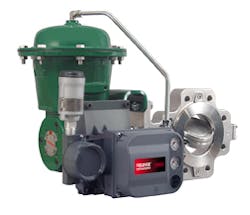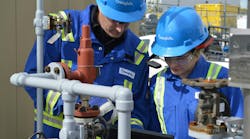Afton Coleman, CFSP is the FIELDVUE SIS Product Manager at Emerson Process Management. She previously held positions at Emerson Process Management in Applications Engineering serving the chemical, pulp and paper, metals and mining, as well as nuclear industries. Coleman has worked with Emerson since 2005, studying safety instrumented system applications since 2007, and became a Certified Functional Safety Professional (CFSP) in 2010. She holds a BSE in Chemical Engineering from the University of Iowa.
Jeff VonAhnen is a FIELDVUE Product Manager at Emerson Process Management where he has worked since 1982. Prior to joining the FIELDVUE team he previously held Manufacturing Support Engineering positions with the Systems and Valve Instrument departments. Since joining the FIELDVUE team in 1995 he has provided technical support and Product Marketing responsibility for the DVC5000, DVC5000f, DVC6000, DVC6000f, and 775 Wireless THUM Adapter product lines and currently serves as the liaison to the HART Communications Foundation for the Fisher business unit of Emerson Process Management. He holds a BS in Mechanical Engineering from Iowa State University.
Q: When it comes to process control, what do you see as the key advantages of digital valve controllers compared to their analog counterparts?
A: Overall, digital valve controllers enable the process user to save time and money. Digital valve controllers provide the user with a stream of valuable information that can be used to operate safer, identify and minimize process variability, plan smarter maintenance, and reduce process downtime.
Specific examples include:
- Standardization lowers the cost of inventory: A single digital valve controller can be used in countless applications and on virtually any valve/actuator combination.
- Same calibration regardless of technician: Digital valve controllers run a software-based calibration script, which results in repeatable calibration. Calibration of analog valve positioners requires fine mechanical adjustments that can vary from instrument to instrument.
- Accessibility to device health and status: Microprocessor-based positioners provide self-monitoring capability and the ability to report status information via a standardized communication protocol (HART, FOUNDATION fieldbus, PROFIBUS, etc.) when it requires attention.
- Higher value function: Specialized on-line diagnostics can highlight issues and valve degradation, such as changes in friction, that otherwise may not be identified, resulting in more reliable valve performance and less lost time and money.
Q: Is there a clear tipping point for end-users when the move from an analog valve solution to a digital valve solution is an absolute requirement? Are there any specific applications you can cite where a digital valve solution might be overkill and/or an analog valve would be preferred?
A: The tipping point for such a decision can be several different factors, which depend on the user’s need. A digital valve solution is especially beneficial in the case that a user requires direct and immediate feedback from the valve assembly regarding anything that may impact performance, reliability or availability. It is also useful in cases where technicians are stressed for efficiency; tools such as automated alert notifications and configuration and calibration wizards can help tremendously. Intelligent valves deliver health and status information directly to the control room and asset management systems, so limited maintenance resources can focus on problem solving and optimizing the process. Some diagnostic software for digital valve controllers even offers potential solutions to alert conditions, which can help less experienced personnel perform advanced troubleshooting.
The ease and repeatability of calibration, as well as the information that the digital valve controller provides, are valuable characteristics, however, there are instances where a digital valve controller cannot physically be used. An example of this would be a remote location where electrical power is not available, as is the case in some gas pipeline applications. In this case an analog solution or battery-operated wireless solution might be preferred. Another application where analog-type instruments tend to be preferred is nuclear high-radiation exposure installations. Microprocessor-based instrumentation has limitations in this type of application.
Q: What are the diagnostic capabilities of today’s digital valves? How have digital valve diagnostics evolved/improved over the past 5-10 years?
A: Diagnostic capabilities can include a combination of communication alerts and performance tests that report on the current health of the valve. Diagnostic tests that control the movement of the valve through a full sweep of valve motion are typically performed when the valve is off-line or can physically move the valve without upsetting the process. Such diagnostic tests provide reports of potential valve, actuator, and instrument health issues such as component malfunction, increased valve friction, stick-slip motion, as well as tuning and performance-related issues.
One of the most significant recent advances includes on-line diagnostics, i.e. valve performance and health evaluation without shutting down the process or pulling the valve assembly from the line. The most advanced digital valve controllers contain multiple on-board sensors, which are capable of performing tests and live readings while the valve continues to follow the normal setpoint changes driven by the process controller. On-line diagnostics are capable of identifying issues such as low air supply, actuator leakage, broken actuator spring, stuck valve, excessive valve friction, excessive valve assembly deadband, calibration shift, and others.
Another recent advancement is the way in which diagnostic information is portrayed to the user. Data is easily displayed using a number of different graphical tools made available with the digital valve controller’s companion software, and some programs provide interpretations and analysis tools within the software. The industry trend is moving toward human-centered graphics and data interpretation tools, as well as the ability to predict problems in valves before they become problems (prognostic ability), and provide suggested corrective actions.
Q: Looking into the future of digital valve technology, what do you see as some of the biggest trends, developments, and/or applications in this area?
A: As digitally communicating host control systems and field devices become more prevalent, there will be a growing need for consistency in communications. Major communication protocols are currently requiring that devices be registered compliant with their protocols, and we believe this trend will continue and likely become more widespread. The positive outcome of this initiative is that it will allow users to integrate and receive information from various manufacturers’ devices without interoperability conflicts.
The availability of HART wireless technology is another notable trend. This has a tremendous potential impact on digital valve technology. There are many instances in plants where valves controlled by digital valve controllers receive their control signals from host systems which do not support and are not capable of digital communications and any diagnostic test results, alerts, or alarms are left “stranded” within the field device when they occur because they do not have a means to communicate this information. Adding a WirelessHART adapter to these digital field devices provides them with a means of communication and enables users to better understand the health and status of valves where information was not previously available.
Q: If there were one piece of information, best practice, or tip, aside from above, that you would like to convey to end-users about digital valve technology, what would it be?
A: The information received from a digital valve controller is only worthwhile if it is used. Construct control strategies from the beginning which utilize the superior status and diagnostic capabilities that the digital valve controller has to offer, and don’t stop there. Develop pre-planned maintenance work practices that react to status information continuously obtained from the digital devices. This will allow you and your personnel to operate faster and smarter with the information at your fingertips.





